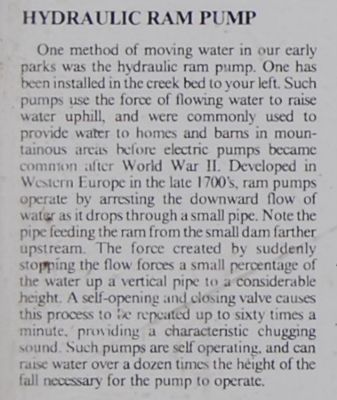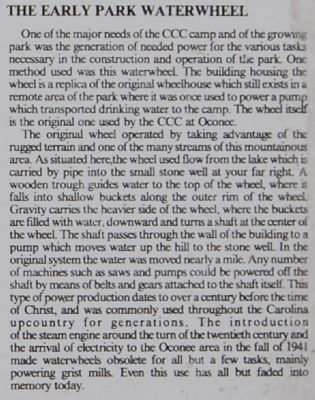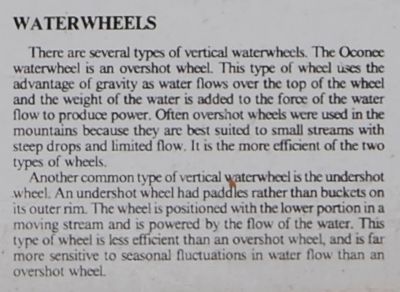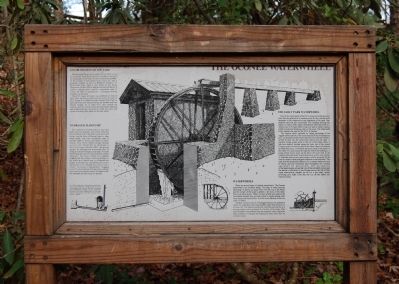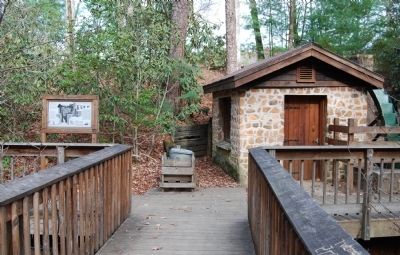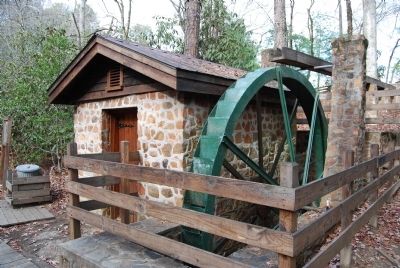Mountain Rest in Oconee County, South Carolina — The American South (South Atlantic)
The Oconee Waterwheel
Inscription.
Establishment of the Park
Oconee State Park was developed in the 1930's as one of the earliest State Parks in South Carolina was built by members of the Civilian Conservation Corp. The CCC was a program created as part of President Franklin D. Roosevelt's New Deal in the midst of the Great Depression of the 1930's to address the dual problems of massive unemployment and the tremendous need to reverse the effect of generations of damaging farming practices on the land.
The CCC camp at Oconee was established in July of 1935. Over the course of the next two years, the man of CCC Camp F-1 worked to create Oconee State Park on land that had been farmed heavily for decades and was heavily eroded. as in other CCC sites around the country, the CCC recruits at Oconee used native materials and traditional local resources to create the many and varied structures that stand on the park today.
Hydraulic Ram Pump
One method of moving water in our early parks was the hydraulic ram pump. One has been installed in the creek bed to your left. Such pumps use the force of flowing water to raise water uphill, and were commonly used to provide water to homes and barns in mountainous areas before electric pumps became common after World War II. Developed in Western Europe in the late 1700's, ram pumps operate by arresting the downward flow of water as it drops through a small pipe. Note the pipe feeding th ram from the small dam farther upstream. The force created by suddenly stopping the flow forces a small percentage of the water up a vertical pipe in a considerable height. A self-operating and closing valve causes this process to be repeated up to sixty times a minute, providing a characteristic chugging sound. Such pumps are self operating and cal raise water over a dozen times the height of the fall necessary for the pump to operate.
The Early Park Waterwheel
One of the major needs of the CCC camp and of the growing park was the generation of needed power for the various tasks necessary in the construction and operation of the park. One method used was this waterwheel. The building housing the wheel is a replica of the original wheelhouse which still exists in a remote area of the park where it was once used to power a pump which transported drinking water to the camp. The wheel itself is the original one used by the CCC at Oconee.
The original water wheel operated by taking advantage of the rugged terrain and one of the many streams of this mountainous area. As situated here, the wheel used flow from the lake which is carried by pipe into the small stone well at your far right. A wooden trough guides water to the top of the wheel, where the buckets are filled with water, downward and turns a shaft at the center of the wheel. The shaft passes through the wall of the building to a pump which moves water up the hill to the stone well. In the original system the the water was moved nearly a mile. Any number of machines such as saws and pumps could be powered off the shaft by means of belts and gears attached to the shaft itself. This type of power production dates to over a century before the time of Christ, and was commonly used throughout the Carolina upcountry for generations. The introduction of the steam engine around the turn of the twentieth century and the arrival of electricity to the Oconee area in the fall of 1941 made waterwheels obsolete for all but a few tasks, mainly powering grist mills. even this use has all but faded into memory today.
Waterwheels
There are several types of vertical waterwheels. The Oconee waterwheel is an overshot wheel. This type of wheel uses the advantage of gravity as water flows over the top of the wheel and the weight of the water is added to the force of the water flow to produce power. Often overshot wheels were used in the mountains because they are best suited to small streams with steep drops and limited flow. It is the more effective of the two types of wheels.
Another common type of vertical waterwheel is the undershot wheel. An undershot wheel
had paddles rather than buckets on its outer rim. The sheel is positiobed with the lower portion in a moving stream and is powered by the flow of the warer, and is far more sensitive to seanonal fluctuations in water flow than an overshot wheel.
Topics. This historical marker is listed in these topic lists: Industry & Commerce • Parks & Recreational Areas • Waterways & Vessels. A significant historical month for this entry is July 1935.
Location. 34° 51.85′ N, 83° 6.259′ W. Marker is in Mountain Rest, South Carolina, in Oconee County. Marker is on State Park Road. Touch for map. Marker is at or near this postal address: 624 State Park Road, Mountain Rest SC 29664, United States of America. Touch for directions.
Other nearby markers. At least 10 other markers are within 4 miles of this marker, measured as the crow flies. Building a Tradition (about 300 feet away, measured in a direct line); Cherokee Boundary (1777) (about 400 feet away); Oconee State Park (about 500 feet away); Civilian Conservation Corps Monument (about 500 feet away); The Civilian Conservation Corps (about 500 feet away); A Building with a Past (about 500 feet away); Mountain Rest School / Hillbilly Day (approx. 2.3 miles away); Oconee Station / Oconee County (approx. 2.3 miles away); Oconee Town (approx. 2.7 miles away); Chauga Town (approx. 3.1 miles away). Touch for a list and map of all markers in Mountain Rest.
Also see . . .
1. Civilian Conservation Corps. The Civilian Conservation Corps (CCC) was a work relief program for young men from unemployed families, established on March 21, 1933, by U.S. President Franklin D. Roosevelt. (Submitted on December 11, 2008, by Brian Scott of Anderson, South Carolina.)
2. Civilian Conservation Corps (CCC), 1933-1941. In 1932, when the American public voted President Herbert Hoover out of office, they were searching for an end to the economic chaos and unemployment that had gripped the nation for two years. (Submitted on December 11, 2008, by Brian Scott of Anderson, South Carolina.)
Credits. This page was last revised on August 5, 2021. It was originally submitted on December 10, 2008, by Brian Scott of Anderson, South Carolina. This page has been viewed 2,140 times since then and 59 times this year. Photos: 1, 2, 3, 4, 5, 6. submitted on December 10, 2008, by Brian Scott of Anderson, South Carolina. 7. submitted on December 11, 2008, by Brian Scott of Anderson, South Carolina.

